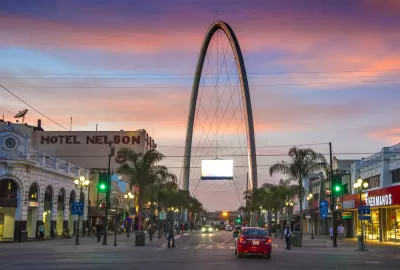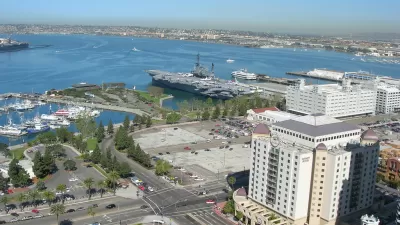On a recent tour of Tijuana for young land use professionals, San Diego architect Marin Gertler found a city that used the drought of U.S. tourism in the last decade to redefine and refine its urban core.

The combination of cartel violence and the U.S. recession were a one-two punch to the downtown Tijuana retail and restaurant economy. Long dependent on day tripper tourists and young American revelers, Tijuana was known primarily for its hawkers selling everything from tacky curios, to margaritas and beer, to more illicit goods and services—not to mention the tourists, many tacky themselves, who ambled or drunkenly stumbled down its streets.
The well publicized cartel violence, including some gun battles in Tijuana itself, deterred tourism. The recession, internet shopping, and long border waits all likely played a role too. Many Tijuana businesses, dependent on tourism, closed down, and the city's main tourist street, Avenida Revolucion, became a "ghost town of empty commercial spaces and former bars." However, this weaning from tourism (of the lowest variety) may have had a silver lining. On a recent tour put on by the Urban Land Institute San Diego/Tijuana Young Leader Partnership Forum, San Diego Gensler architect Marin Gertler found a revitalizing Tijuana urban core, not so dependent on tourism and catering more to young creatives—both local and from across the border. He writes about three stops on the tour that particularly inspired him. Find out more at the source article.
FULL STORY: Three great things happening now in downtown Tijuana, Baja California

Planetizen Federal Action Tracker
A weekly monitor of how Trump’s orders and actions are impacting planners and planning in America.

San Francisco's School District Spent $105M To Build Affordable Housing for Teachers — And That's Just the Beginning
SFUSD joins a growing list of school districts using their land holdings to address housing affordability challenges faced by their own employees.

The Tiny, Adorable $7,000 Car Turning Japan Onto EVs
The single seat Mibot charges from a regular plug as quickly as an iPad, and is about half the price of an average EV.

With Protected Lanes, 460% More People Commute by Bike
For those needing more ammo, more data proving what we already knew is here.

In More Metros Than You’d Think, Suburbs are Now More Expensive Than the City
If you're moving to the burbs to save on square footage, data shows you should think again.

The States Losing Rural Delivery Rooms at an Alarming Pace
In some states, as few as 9% of rural hospitals still deliver babies. As a result, rising pre-term births, no adequate pre-term care and "harrowing" close calls are a growing reality.
Urban Design for Planners 1: Software Tools
This six-course series explores essential urban design concepts using open source software and equips planners with the tools they need to participate fully in the urban design process.
Planning for Universal Design
Learn the tools for implementing Universal Design in planning regulations.
Smith Gee Studio
City of Charlotte
City of Camden Redevelopment Agency
City of Astoria
Transportation Research & Education Center (TREC) at Portland State University
US High Speed Rail Association
City of Camden Redevelopment Agency
Municipality of Princeton (NJ)



























